Distribution Map of Frost Resistance for Cement-Based Materials Based on Pore Structure Change
Abstract
1. Introduction
2. Materials and Methods
3. Model Development
3.1. Results for Pore Structure Change Due to Environmental Conditions
3.2. Model for Predicting Frost Resistance Based on Pore Structure Change
4. Model Validation and Discussion: An Application Related to Japan’s Climate
5. Conclusions
- It was confirmed that the change in pore structure due to drying at high temperature in the summer greatly decreased the durability factor of cement-based materials, as the annual maturity value based on time, temperature, and humidity was larger.
- A distribution map of frost damage risk was created using meteorological data for the frost damage deterioration of mortar. The service life becomes shorter when considering the influence of summer drying. From the distribution map of the service life assuming the same durability index, it became clear that the deterioration progressed rapidly and the service life was significantly reduced by considering the drying.
- It was found that, even in warm regions, the risk of frost damage could be the same as in cold regions when taking into account the effects of drying, and that the tendency was more pronounced for concrete with a low durability factor.
- The environment index and its distribution map established and created by this research can be used for regional evaluation as well as proposed utilization for applications such as management that contribute to extending the life of buildings.
- The climate data of each country around the world can be used for prediction model, therefore, future work is also needed to investigate the effect of various climate types such as tropical, temperate and polar on prediction model and develop a software using the results of this study.
Author Contributions
Funding
Acknowledgments
Conflicts of Interest
References
- Neville, A.M. Properties of Concrete, 5th ed.; Pearson: London, UK, 2012. [Google Scholar]
- Mehta, P.K.; Monteiro, P.J.M. Concrete: Microstructure, Properties and Materials, 4th ed.; McGraw-Hill Education: New York, NY, USA, 2014. [Google Scholar]
- Zuber, B.; Marchand, J. Modeling the deterioration of hydrated cement systems exposed to frost action Part I: Description of the mathematical model. Cem. Concr. Res. 2000, 30, 1929–1939. [Google Scholar] [CrossRef]
- Hayashida, H.; Hama, Y.; Endo, H. Study on Correction of Moisture Condition in Frost Damage Degradation Prediction. Proc. Jpn. Concr. Inst. 2011, 33, 917–922. [Google Scholar]
- Coussy, O.; Monteiro, P. Poroelastic model for concrete exposed to freezing temperatures. Cem. Concr. Res. 2008, 38, 40–48. [Google Scholar] [CrossRef]
- Duan, A.; Tian, Y.; Dai, J.G.; Jin, W.L. A stochastic damage model for evaluating the internal deterioration of concrete due to freeze–thaw action. Mater. Struct. 2014, 47, 1025–1039. [Google Scholar] [CrossRef]
- Aghabaglou, A.M.; Cakir, O.A.; Ramyar, K. Freeze–thaw resistance and transport properties of high-volume fly ash roller compacted concrete designed by maximum density method. Cem. Concr. Compos. 2013, 37, 259–266. [Google Scholar] [CrossRef]
- Shang, H.S.; Song, Y.P. Experimental study of strength and deformation of plain concrete under biaxial compression after freezing and thawing cycles. Cem. Concr. Res. 2006, 36, 1857–1864. [Google Scholar] [CrossRef]
- Setzer, M.J.; Heine, P.; Kasparek, S.; Palecki, S.; Auberg, R.; Feldrappe, V.; Siebel, E. Test methods of frost resistance of concrete: CIF-Test: Capillary suction, internal damage and freeze thaw test—Reference method and alternative methods A and B. Mater. Struct. 2004, 37, 743–753. [Google Scholar] [CrossRef]
- Choi, H.; Zhang, W.; Hama, Y. Method for determining early-age frost damage of concrete by using air-permeability index and influence of early-age frost damage on concrete durability. Constr. Build. Mater. 2017, 153, 630–639. [Google Scholar] [CrossRef]
- Bazant, Z.P.; Chern, J.-C. Mathematical model for freeze-thaw durability of concrete. J. Am. Ceram. Soc. 1988, 71, 776–783. [Google Scholar] [CrossRef]
- Hasegawa, K.; Hon, E. Influence of External Factors on Frost Damage of Concrete and Frost Damage Risk in Japan; Research Report; Faculty of Engineering, Hokkaido University: Hokkaido, Japan, 1979. (In Japanese) [Google Scholar]
- Hama, Y.; Senbu, O.; Tomosawa, F. Effect of curing condition before freezing and thawing test to frost resistance of high performance concrete. In Proceedings of the 6th International Symposium on High Strength/High Performance Concrete, Leipzig, Germany, June 2002; pp. 1017–1025. [Google Scholar]
- Hama, Y.; Kamada, E.; Han, C.G. An experimental study on frost resistance of concrete considering drying effects. In Proceedings of the International RILEM Workshop on Resistance of Concrete to Freezing and Thawing with or without de-icing Chemicals, Essen, Germany, 22–23 September 1997; pp. 207–214. [Google Scholar]
- ASTM. C666/C666M—15 Standard Test Method for Resistance of Concrete to Rapid Freezing and Thawing; ASTM International: West Conshohocken, PA, USA, 2015. [Google Scholar]
- Hama, Y.; Matsumura, K.; Tabata, M.; Tomiita, T.; Kamada, E. Estimation of frost damage of concrete based on meteorological factors. J. Struct. Constr. Eng. 1999, 523, 9–16. [Google Scholar] [CrossRef]
- Hama, Y.; Aono, Y.; Shibata, S. Influence of micro-cracks on frost resistance of high performance concrete. In Proceedings of the International Conference on Durability of HPC and Final Workshop of CONLIFE, AEDIFICATIO, Essen, Germany, 23–24 September 2004; pp. 267–276. [Google Scholar]
- Aono, Y.; Matsushita, F.; Shibata, S.; Hama, Y. Study on Frost Resistance and Its Degradation Mechanism of Concrete Subjected to Drying and Wetting Cycles. J. Struct. Constr. Eng. 2006, 607, 15–22. [Google Scholar] [CrossRef][Green Version]
- Kamada, E.; Senbu, O.; Tabata, M.; Tanaka, H. Statistical Investigation Concerning the Effects of Pore Structure on The Frost Resistance of Concrete. J. Struct. Constr. Eng. 1996, 487, 1–9. [Google Scholar]
- Shibuya, M.; Hama, Y.; Osaka, S.; Kishimoto, Y. Relationship between pore structure change and frost damage resistance of outdoor exposed mortar. Proc. Arch. Inst. Jpn. 2010, A-1, 1275–1276. [Google Scholar]
- Nakamura, T.; Hama, Y.; Kishimoto, Y.; Zakaria, M. Proposal of Prediction Formula for Frost Resistance Due to Pore Structural Change of Mortar by Drying. Proc. Jpn. Concr. Inst. 2013, 35, 925–930. [Google Scholar]
- Nakamura, T.; Hama, Y.; Taniguchi, M. Relationship Between the Change of Volume of Pore Size 40-2000 nm Diameter Macro Pore of Mortar in Drying Condition and Maturity. J. Struct. Constr. Eng. 2015, 713, 981–989. [Google Scholar] [CrossRef][Green Version]
- Aono, Y.; Matsushita, F.; Shibata, S.; Hama, Y. Nano-structural changes of C-S-H in hardened cement paste during drying at 50 °C. J. Adv. Concr. Technol. 2007, 5, 313–323. [Google Scholar] [CrossRef]
- Hama, Y.; Kishimoto, Y.; Zakaria, M. Frost resistance and micro pore structure change of mortar exposed to different climate conditions. In Proceedings of the RILEM Proceedings, 2nd International Conference on Microstructural-related Durability of Cementitious Composites, Amsterdam, The Netherlands, 11–13 April 2012; pp. 630–638. [Google Scholar]
- Marusin, S. The effect of variation in pore structure on the frost resistance of porous materials. Cem. Concr. Res. 1981, 11, 115–124. [Google Scholar] [CrossRef]
- Kamada, E. Frost damage of concrete and pore structure of hardened cement paste. Proc. Jpn. Concr. Inst. 1988, 101, 51–60. [Google Scholar]
- Sun, W.; Zhang, Y.M.; Yan, H.D.; Mu, R. Damage and damage resistance of high strength concrete under the action of load and freeze–thaw cycles. Cem. Concr. Res. 1999, 29, 1519–1523. [Google Scholar] [CrossRef]
- Hama, Y.; Kamada, E. Strength development under freezing conditions and freezing behavior of water in concrete with accerelatores for freeze protection. Concr. Res. Technol. 1997, 8, 73–80. [Google Scholar] [CrossRef][Green Version]
- Beaudoin, J.J.; Macinnis, C. The mechanism of frost damage in hardened cement paste. Cem. Concr. Res. 1974, 4, 139–147. [Google Scholar] [CrossRef]
- Hanjari, K.Z.; Utgenannt, P.; Lundgrent, K. Experimental study of the material and bond properties of frost-damaged concrete. Cem. Concr. Res. 2011, 41, 244–254. [Google Scholar] [CrossRef]
- Tang, L.; Petersson, P.E. Slab test: Freeze/thaw resistance of concrete—Internal deterioration. Mater. Struct. 2004, 37, 754–759. [Google Scholar] [CrossRef]
- Powers, T.C. A working hypothesis for further studies of frost resistance of concrete. J. Am. Concr. Inst. 1945, 16, 245–271. [Google Scholar]
- Geiker, M.R.; Laugesen, P. On the effect of laboratory conditioning and freeze/thaw exposure on moisture profiles in HPC. Cem. Concr. Res. 2001, 31, 1831–1836. [Google Scholar] [CrossRef]
- Powers, T.C. Frost resistant concrete. J. PCA. Res. Dev. Lab. 1964, 6, 19. [Google Scholar]
- Washburn, E.W. The Dynamics of Capillary Flow. Phys. Rev. 1921, 17, 273–283. [Google Scholar] [CrossRef]
- Abell, A.B.; Willis, K.L.; Lange, D.A. Mercury Intrusion Porosimetry and Image Analysis of Cement-based Materials. J. Coll. Interf. Sci. 1999, 211, 39–44. [Google Scholar] [CrossRef]
- Wu, M.; Johannesson, B.; Geiker, M. A study of the water vapor sorption isotherms of hardened cement pastes: Possible pore structure changes at low relative humidity and the impact of temperature on isotherms. Cem. Concr. Res. 2014, 56, 97–105. [Google Scholar] [CrossRef]
- Suwanmaneechot, P.; Aili, A.; Maruyama, I. Creep behavior of C-S-H under different drying relative humidities: Interpretation of microindentation tests and sorption measurements by multi-scale analysis. Cem. Concr. Res. 2020, 132. (In Progress) [Google Scholar] [CrossRef]
- Jennings, H.M. A model for the microstructure of calcium silicate hydrate in cement paste. Cem. Concr. Res. 2000, 30, 101–116. [Google Scholar] [CrossRef]
- Carino, N.J.; Lew, H.S. The Maturity Method: From Theory to Application. In Proceedings of the 2001 Structures Congress and Exposition, Washington, DC, USA, 21–23 May 2001; p. 19. [Google Scholar]
- Quy, N.X.; Kim, J.; Hama, Y. Effect of 10-Year Outdoor Exposure and Curing Conditions on the Pore Structure Characteristics of Hardened Cement Mortar. J. Adv. Concr. Technol. 2018, 16, 461–475. [Google Scholar] [CrossRef]
- Japan Climate Index: Part 1, Part 5; Japan Meteorological Agency: Tokyo, Japan, 1982.
- Japan Meteorological Agency. Available online: https://www.jma.go.jp/jma/indexe.html (accessed on 6 September 2018).
- Hama, Y.; Kamada, E.; Tabata, M.; Koh, Y. Study on the relationship between environmental conditions and standard method of freezing-and-thawing test (ASTM C666 A) on frost resistance of concrete. Durability of building materials and components 6. In Proceedings of the Sixth International Conference held in Omiya, Omiya, Japan, 26–29 October 1993; Nagataki, S., Nireki, T., Tomosawa, F., Eds.; E & FN SPON an Imprint of Chapman & Hall: London, UK, 1993. [Google Scholar]
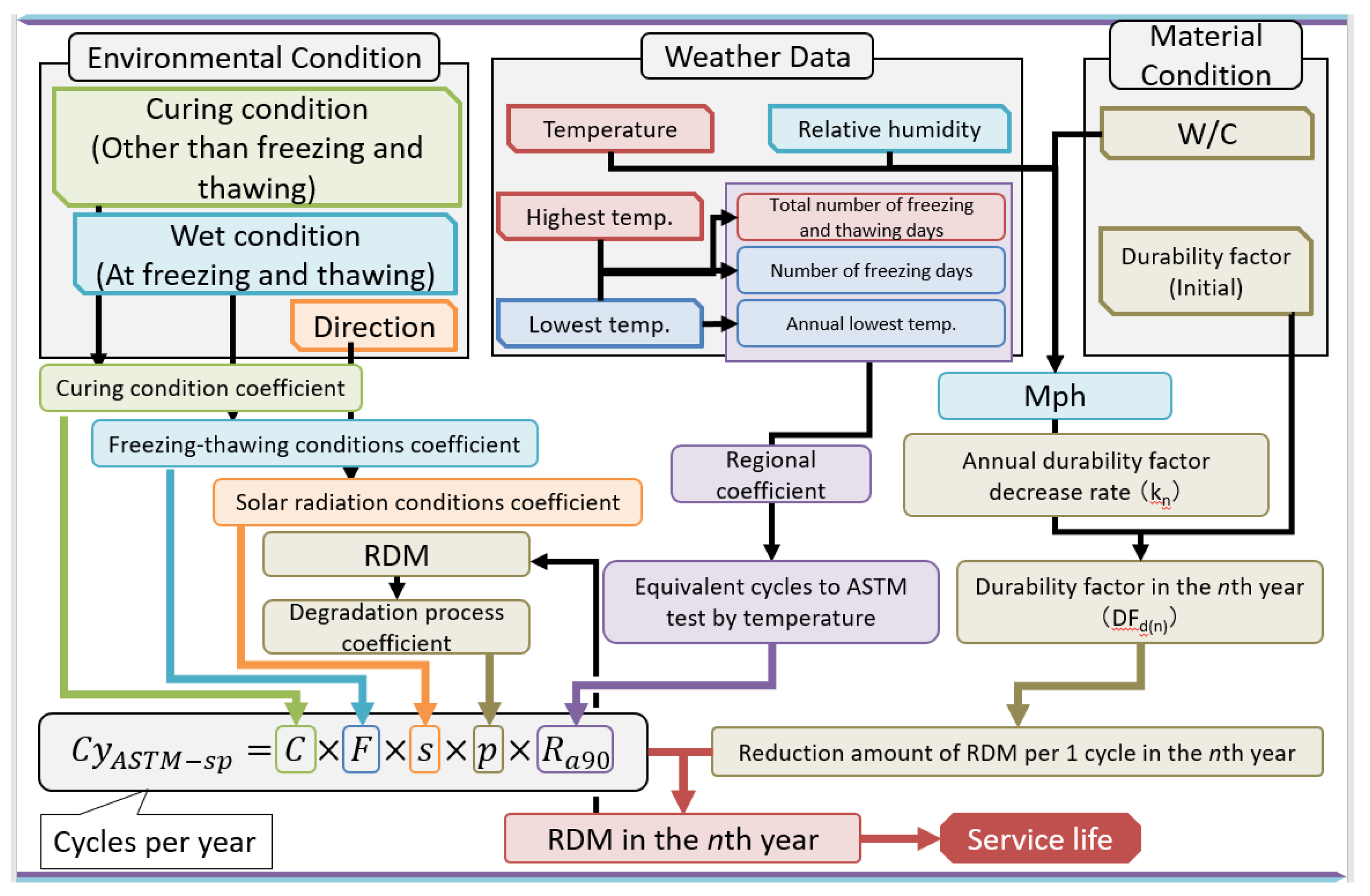
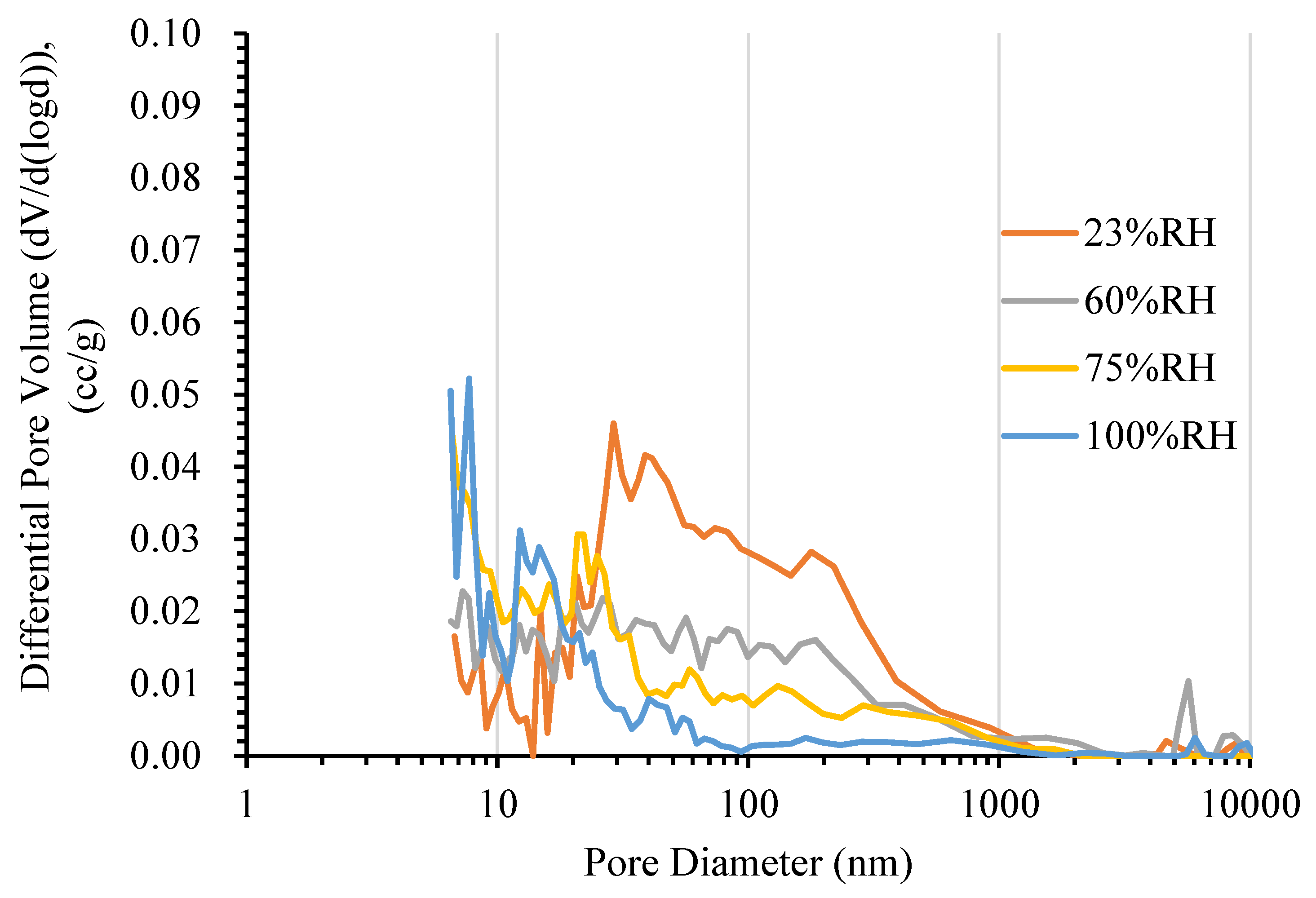
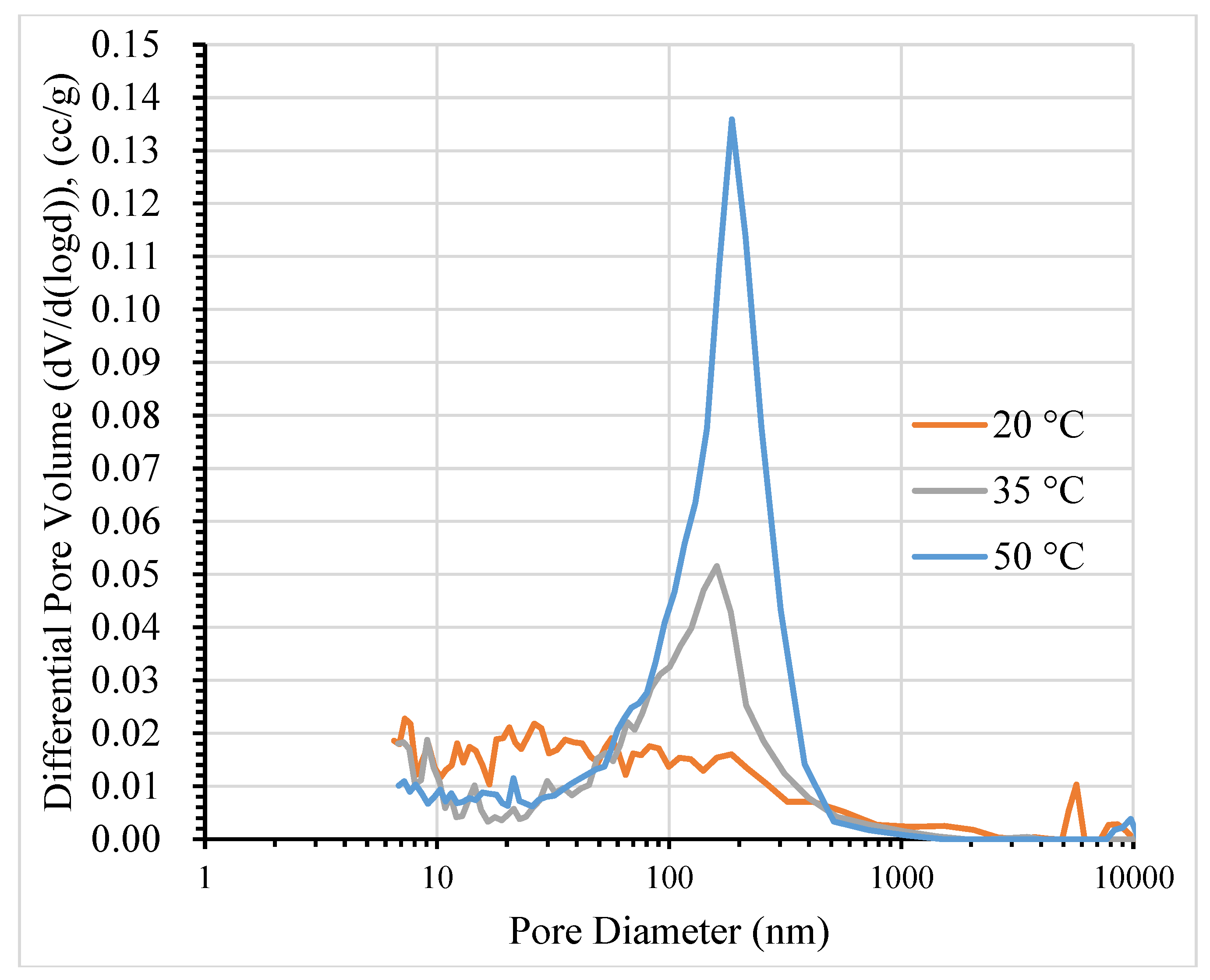
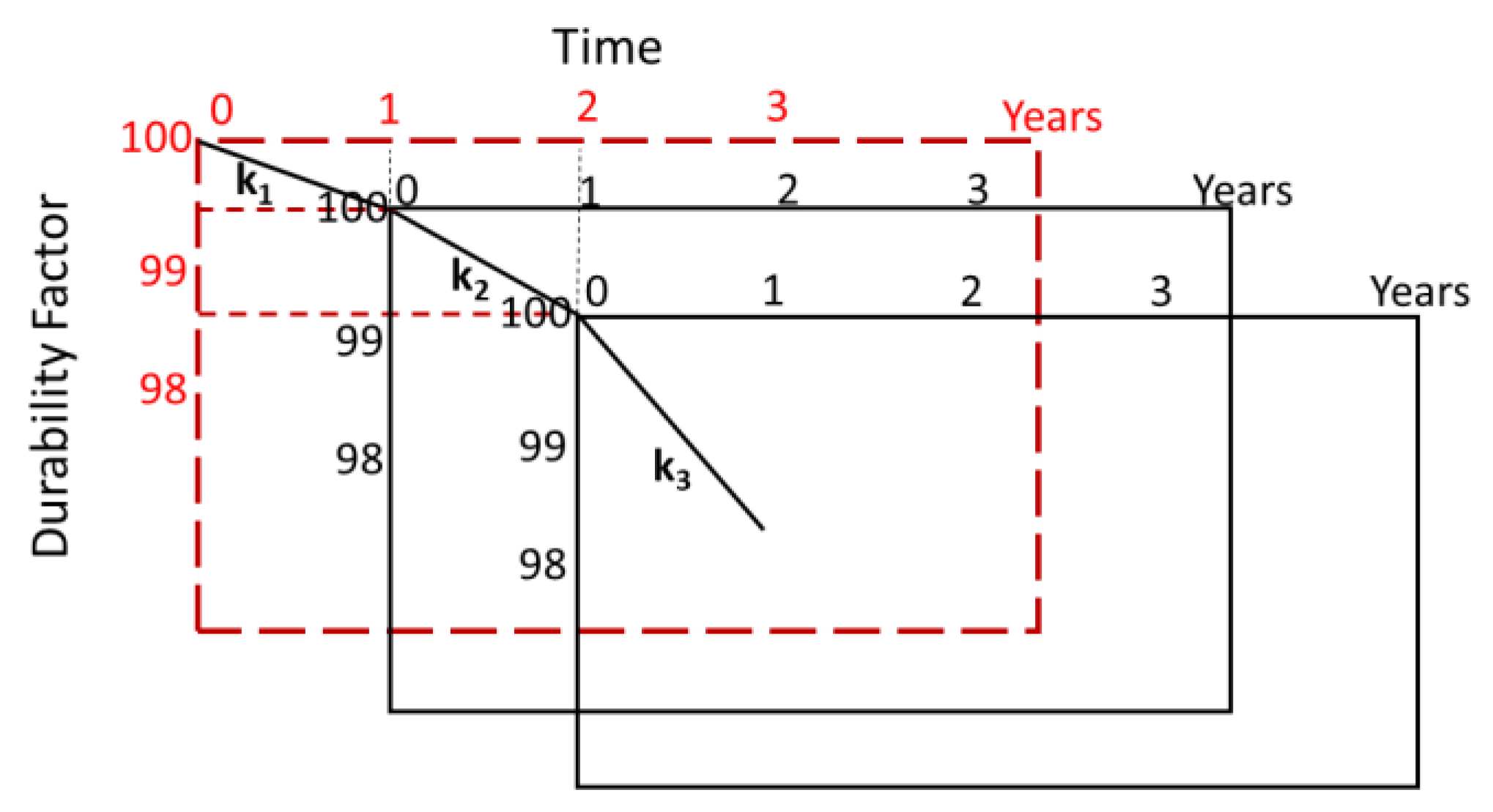
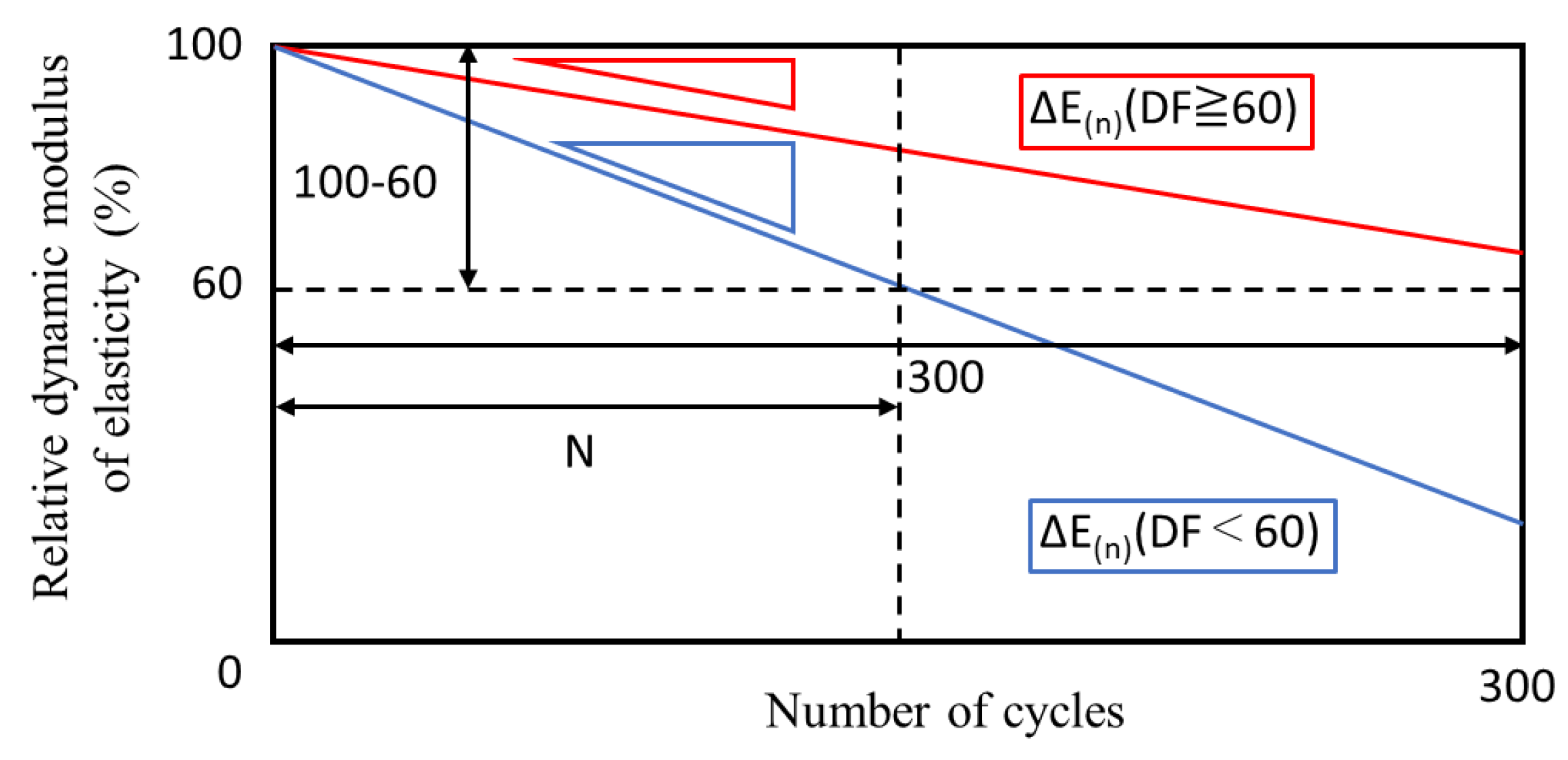
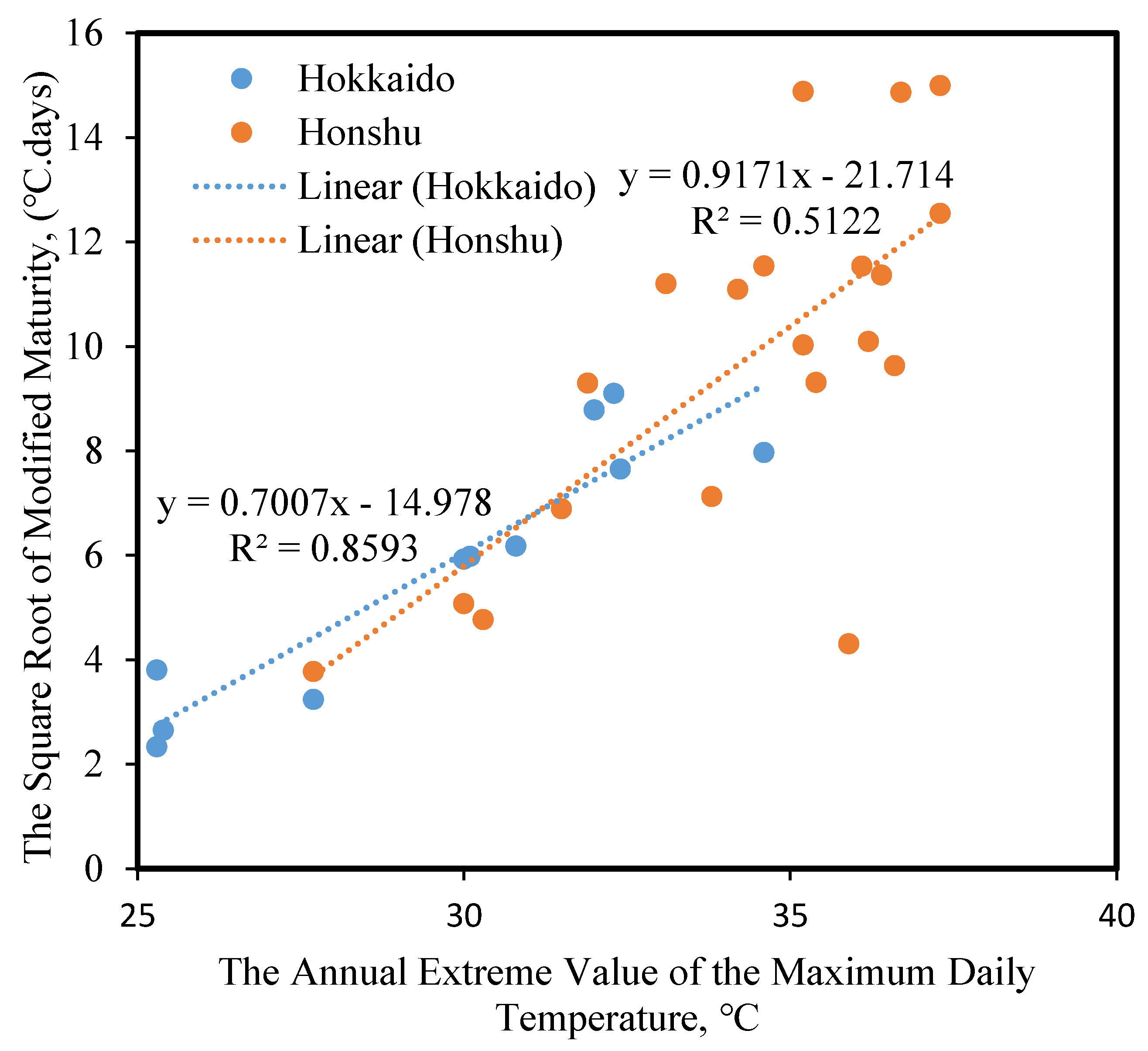
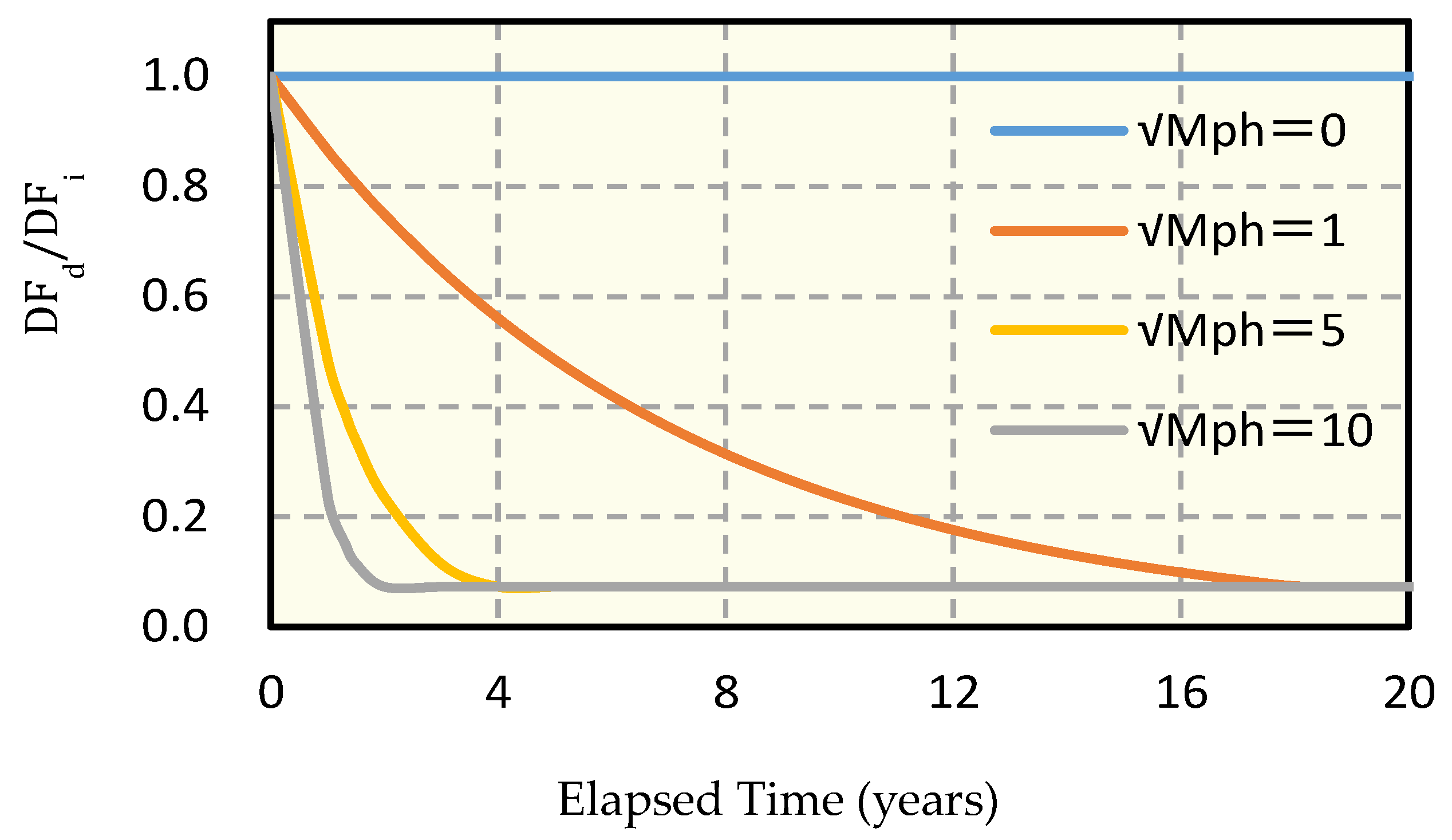
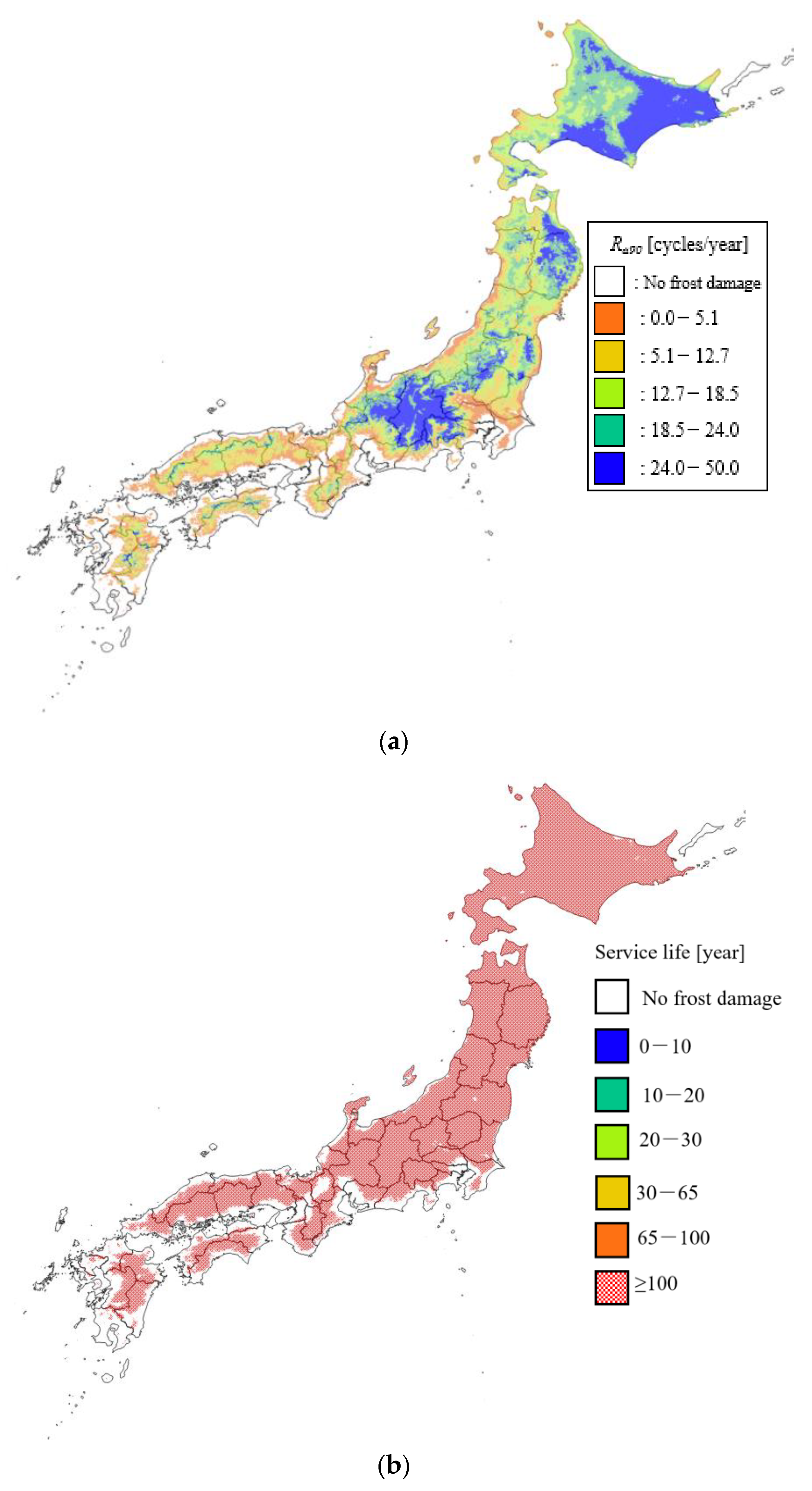
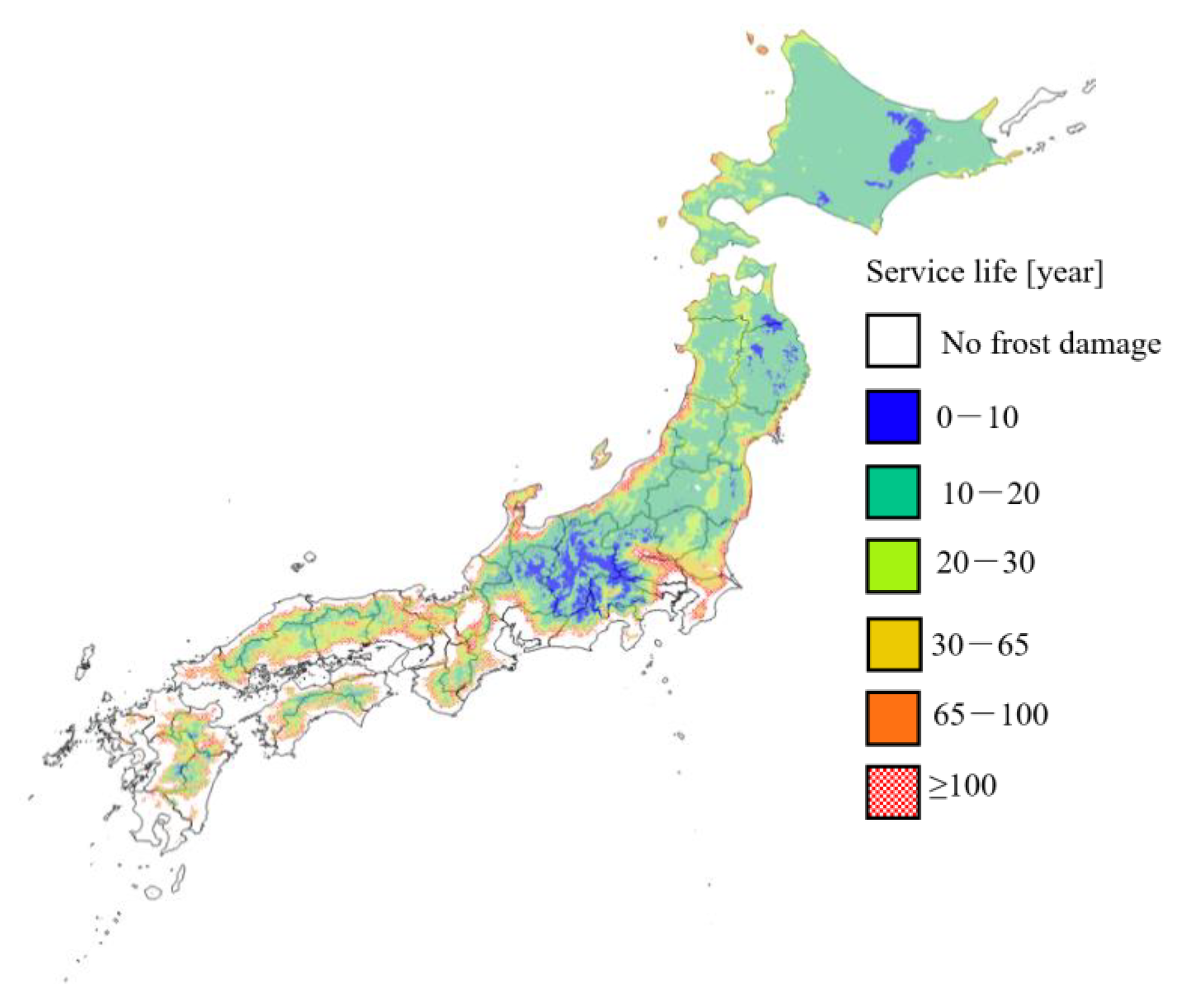
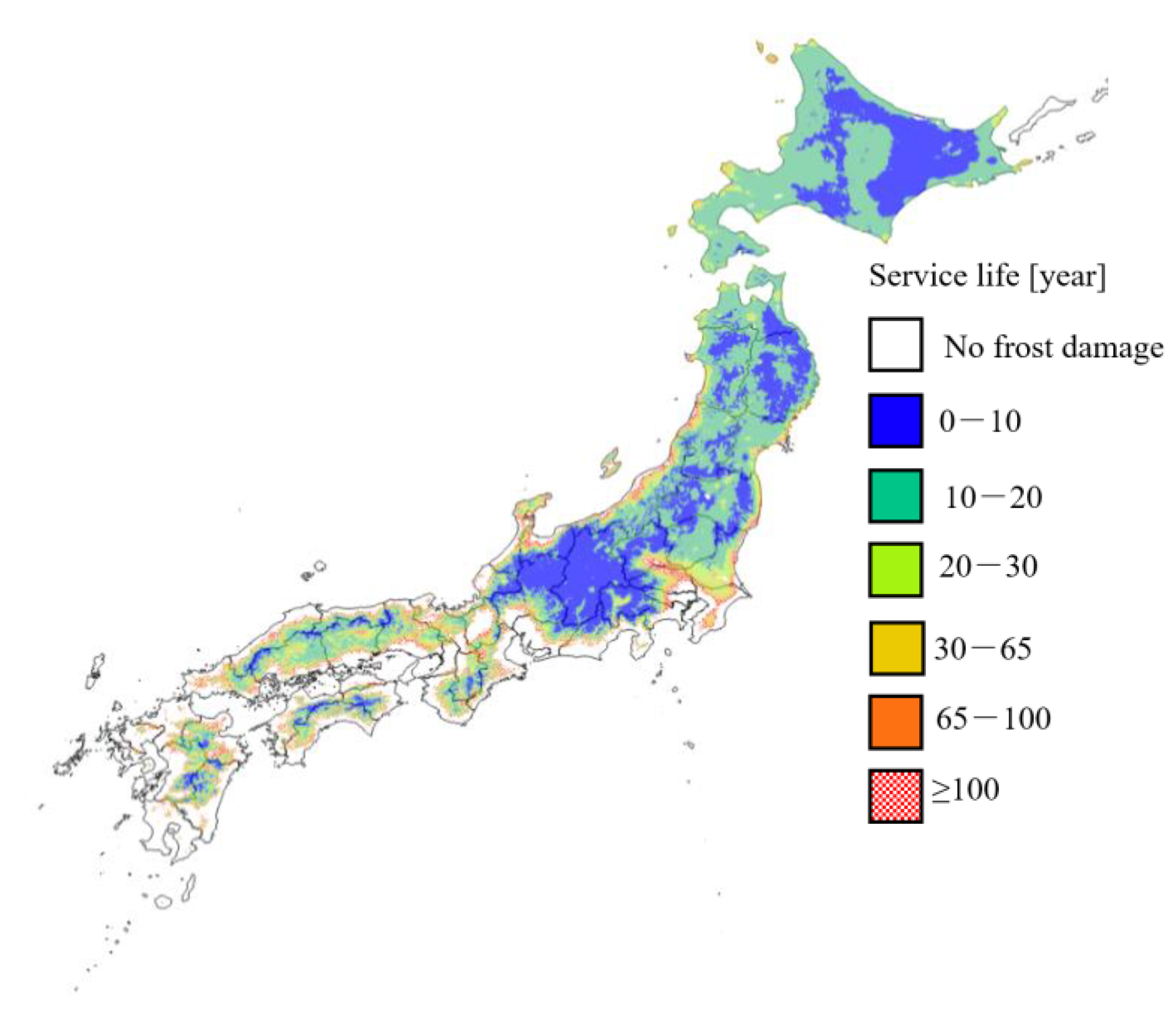
| Items | Unit | Testing Value |
|---|---|---|
| Specific gravity | g/cm3 | 3.161 |
| Specific surface area | cm2/g | 3368 |
| MgO | % | 2.0 |
| SO3 | % | 1.8 |
| SiO2 | % | 22.6 |
| Al2O3 | % | 6.2 |
| Fe2O3 | % | 3.1 |
| CaO | % | 62.3 |
| LOI | % | 0.68 |
| ASTM Equivalent Cycles, CyASTM-sp = C.F.s.p.Ra90 | Process of Frost Damage | |||
|---|---|---|---|---|
| Signal 100% ≥ Ed > 90% | Clear 90% ≥ Ed > 60% | |||
| Degradation coefficient (p) | 1.00 | 1.64 | ||
| Condition Coefficients | Solar radiation (s) | North face | 1.00 | 1.00 |
| South face | 1.45 | 1.45 | ||
| Curing and drying (C) C | In water | 1.00 | 1.00 | |
| In air | 0.66 | 1.41 | ||
| Drying at 20 °C | 0.26 | 0.80 | ||
| Drying at 30 °C | 0.14 | 0.45 | ||
| Freeze–thaw (F) | In water | 1.00 | 1.00 | |
| Freezing in air and thawing in water | 0.21 | 0.23 | ||
| Region/City | CyASTM-sp | Modified Maturity Mph (°C·day) | ||
|---|---|---|---|---|
| CyASTM-90 | CyASTM-60 | |||
| Hokkaido | Wakkanai | 0.3 | 1.4 | 14.2 |
| Kitami | 0.6 | 3.2 | 37.7 | |
| Asahikawa | 1.1 | 6.2 | 81.9 | |
| Abashiri | 0.8 | 4.2 | 35.3 | |
| Sapporo | 0.9 | 4.8 | 76.2 | |
| Obihiro | 1.7 | 9.3 | 62.8 | |
| Nemuro | 0.7 | 3.8 | 6.9 | |
| Suttsu | 0.5 | 3.0 | 34.6 | |
| Muroran | 0.6 | 3.3 | 10.3 | |
| Urakawa | 1.2 | 6.9 | 5.3 | |
| Hakodate | 1.3 | 7.0 | 57.7 | |
| Honshu | Aomori | 0.7 | 4.1 | 71.0 |
| Hachinohe | 0.8 | 4.5 | 50.1 | |
| Akita | 0.4 | 2.0 | 100.7 | |
| Morioka | 1.1 | 6.2 | 85.4 | |
| Miyako | 0.7 | 4.1 | 46.8 | |
| Sendai | 0.2 | 1.2 | 85.6 | |
| Yamagata | 0.6 | 3.3 | 131.6 | |
| Fukushima | 0.2 | 1.2 | 155.8 | |
| Tochigi | 1.3 | 7.0 | 25.4 | |
| Utsunomiya | 0.4 | 2.2 | 133.5 | |
| Karuizawa | 1.9 | 10.5 | 22.4 | |
| Matsumoto | 1.1 | 5.8 | 154.0 | |
| Kofu | 0.3 | 1.7 | 218.7 | |
| Takayama | 1.1 | 6.0 | 119.1 | |
| Okayama | 0.2 | 1.2 | 158.5 | |
| Asozan | 0.9 | 5.1 | 14.0 | |
| Yufuin | 0.4 | 2.0 | 107.3 | |
© 2020 by the authors. Licensee MDPI, Basel, Switzerland. This article is an open access article distributed under the terms and conditions of the Creative Commons Attribution (CC BY) license (http://creativecommons.org/licenses/by/4.0/).
Share and Cite
Xuan Quy, N.; Noguchi, T.; Na, S.; Kim, J.; Hama, Y. Distribution Map of Frost Resistance for Cement-Based Materials Based on Pore Structure Change. Materials 2020, 13, 2509. https://doi.org/10.3390/ma13112509
Xuan Quy N, Noguchi T, Na S, Kim J, Hama Y. Distribution Map of Frost Resistance for Cement-Based Materials Based on Pore Structure Change. Materials. 2020; 13(11):2509. https://doi.org/10.3390/ma13112509
Chicago/Turabian StyleXuan Quy, Nguyen, Takumi Noguchi, Seunghyun Na, Jihoon Kim, and Yukio Hama. 2020. "Distribution Map of Frost Resistance for Cement-Based Materials Based on Pore Structure Change" Materials 13, no. 11: 2509. https://doi.org/10.3390/ma13112509
APA StyleXuan Quy, N., Noguchi, T., Na, S., Kim, J., & Hama, Y. (2020). Distribution Map of Frost Resistance for Cement-Based Materials Based on Pore Structure Change. Materials, 13(11), 2509. https://doi.org/10.3390/ma13112509





